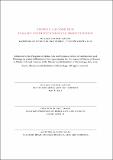Growing a second skin : towards synthetic biology in product design
Author(s)
Patrick, William Graham, S.M. Massachusetts Institute of Technology
DownloadFull printable version (11.11Mb)
Other Contributors
Massachusetts Institute of Technology. Department of Materials Science and Engineering.
Advisor
Neri Oxman.
Terms of use
Metadata
Show full item recordAbstract
Synthetic biology is a rapidly growing engineering discipline widely used in biotechnological applications. However, there are few examples of using synthetic biology in product design and there are even fewer - perhaps no - examples of incorporating fluids containing synthetic organisms and biomolecules into a product. The goals of this thesis are two-fold. First, the author investigates how to contain and control fluids in 3D printed fluid channels. 3D printing methods are characterized by their ability to create fluidic channels that are compatible with biochemistry and culturing microorganisms. Second, the author explores how to design the materiality and geometry of the fluid channels to affect biological function. These goals are pursued in two distinct projects: DNA assembly in 3D printed fluidics and Mushtari, a fluidic wearable designed to contain cyanobacteria and E. coli cultures. Contributions include (1) characterizing the resolution of three 3D printing methods for creating fluidic channels, (2) demonstrating compatibility of 3D printing methods with cell culture and DNA assembly biochemistry, (3) demonstrating the capability to print wearable-scale millifluidic networks up to 58 meters in length, and (4) developing approaches for fabricating geometrically complex fluidic systems.
Description
Thesis: S.M., Massachusetts Institute of Technology, Department of Materials Science and Engineering, 2015. This electronic version was submitted by the student author. The certified thesis is available in the Institute Archives and Special Collections. Cataloged from student-submitted PDF version of thesis. Includes bibliographical references (pages 111-120).
Date issued
2015Department
Massachusetts Institute of Technology. Department of Materials Science and EngineeringPublisher
Massachusetts Institute of Technology
Keywords
Materials Science and Engineering.